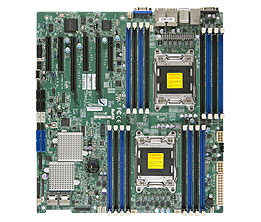It seems to be raining new dual Intel Xeon E5-2600 series motherboards at the moment. Today we look at the very new Supermicro X9DR7 and X9DRE. Like many we have seen thus far, they are dual Intel E5-2600 LGA 2011 motherboards, but what makes these motherboards different over all the other versions? Let’s take a closer look a the specs and see where this board fits among existing solutions.
Key Features
1. Dual socket R (LGA 2011) supports Intel Xeon E5-2600 series processors
2. Intel C602 chipset; QPI up to 8.0GT/s
3. Up to 512GB DDR3 1600MHz ECC Registered DIMM; 16x DIMM sockets
4. Expansion slots: 2 PCI-E 3.0 x16 and 4 PCI-E 3.0 x8
5. Intel i350 GbE controller (4 ports)
6. 8x SATA2 and 2x SATA3 ports
7. 8x SAS2 (6Gbps) ports via LSI 2308
8. Integrated IPMI 2.0 and KVM with Dedicated LAN
9. 7x USB 2.0 ports (2 rear, 4 via header + 1 Type A)
The Good
The LSI SAS2308 SAS controller in this version can be in IT mode passthrough. The LSI controller’s IR mode as it can also support RAID o, 1 and 10, plus JBOD mode. What would be really interesting is if, the onboard LSI controller’s firmware may be flashable to MegaRAID making it essentially an onboard LSI9240. Adding this controller is great news for storage buffs that also need many PCIe slots for other devices. Often in 2U servers (a common form factor for the Intel Xeon E5-2600 series), one needs only motherboard ports plus a mximum of eight from a RAID controller or HBA to utulize all 2.5″ or 3.5″ drive slots. Speaking of expansion, having two additional PCIe x16 and four PCIe x8 all Gen3 slots is awesome. It opens the way for a great over all server, allowing for a couple of top end video cards, or additional SAS/ RAID controllers, or both and 10GbE LAN. LAN is catered for with 4x 1GbE ports via the Intel i350 chipset, very new but already widely supported. IPMI dedicated LAN is included, which is always nice to have and a very common feature these days.
Points to Improve On
One small gripe is that these board do not have USB 3 support, so for users booting from USB sticks USB 2 speeds are as good as it gets. It is very common to have USB 2 only on dual Intel Xeon E5-2600 server motherboards these days, because Intel’s C600 chipset does not support USB 3 natively. Other than this I cannot see anything else without being picky.
Other Notes
The Supermicro X9DR7-JLN4F looks to be the exact same board but with the SAS2308 shipped in IT mode.
The Supermicro X9DRE-LN4F this board lacks the LSI SAS2308 option and is identical other wise.
Overall, the Supermicro X9DR7-JNL4F is in my top 3 server board choices, as it is an excellent overall board that can do most things very well, these kinds of motherboards are rare. Well done Supermicro.

Supermicro X9DR7-JLN4F Key Specifications
| Physical Stats | |
| Form Factor |
|
| Dimensions |
|
| Processor/Cache | |
| CPU |
|
| Cache |
|
| System Bus |
|
| System Memory | |
| Memory Capacity |
|
| Memory Type |
|
| DIMM Sizes |
|
| Memory Voltage |
|
| Error Detection |
|
| On-Board Devices | |
| Chipset |
|
| SATA |
|
| SAS |
|
| IPMI |
|
| Network Controllers |
|
| Video |
|
| Input / Output | |
| SATA |
|
| SAS |
|
| LAN |
|
| USB |
|
| Video |
|
| Serial Port / Header |
|
| DOM |
|




The inclusion of the 2308 makes these great motherboards. This will be great for 1U servers with 8 Sata III SSDs.
So the X9DR7-LN4F, X9DR7-JLN4F and X9DRD-7LN4F all have the 2308 but only the JLN4F board has IT mode? Or they all have IT mode and the JLN4f just has it shipped to default to that mode? Here is my dumb questions…is JBOD the same as IT mode?
Too bad no IPMI.
@Anit Patel
“8. Integrated IPMI 2.0 and KVM with Dedicated LAN”
IT mode is referred to as passthrough, where the drives are presented to the OS directly.
IT mode has no RAID ability at all.
LSI9211 does IT mode well
JBOD similar to IT mode the drives are presented to the OS, but the controller can also have RAID array at the same time, to me a tiny layer is added between OS and drive as controller needs to setup the JBOD.
LSI9240 does JBOD and RAID
LSI9260 can only do RAID arrays, so a single drive would need to be setup as a one drive array in RAID0
Supermicro legend:
7= LSI SAS controller
3= Intel SAS controller
J= IT mode SAS controller firmware
T= 10GbE
LN4= 4x Intel i350 LAN
Q= Single port IB (QDR, 40 Gbps) w/ QSFP connector
F=IPMI
A= Audio
Others are a little harder